Estimated reading time: 25 minutes
Thinking about joining the ranks of countless homesteaders and raising chickens? Here’s your guide to everything you need to know about getting started.
Whether you want to raise chickens for eggs, meat, or just for fun, this guide will provide you with all the information you need.
Want to save this post for later? Click Here to Pin It On Pinterest!
- Questions to Ask Before You Start
- Tips for Buying Chicks, Pullets, or Chickens
- Tips for Hatching Your Own Chicks
- What Breed of Chickens Should You Get?
- How to Set Up A Brooder
- When to Transition Chickens to an Outdoor Setting
- Designing Your Chicken Coop
- Feeding and Watering Your Mature Chickens
- Dealing With Common Chicken Health Concerns
- How to Keep Predators Away From Your Chickens
- Final Thoughts
- FAQ
Questions to Ask Before You Start
Why Should You Keep Chickens?
There are several advantages to having chickens in your backyard.
For starters, they produce eggs (which are pretty pricey these days). If you're trying to be more sustainable and eat healthier, then having access to fresh eggs can be a great way to achieve that goal. You'll also get plenty of delicious meat.
Chickens can also provide natural fertilizer for your garden. Their droppings contain nitrogen and other nutrients which help plants grow bigger and stronger.
Plus, they make great pest control. The chicken's pecking action helps get rid of insects and other pests who might otherwise damage your garden or lawn.
Finally, having chickens around can give you a sense of self-sufficiency and security, knowing that you can provide for yourself if needed.
What Are the Laws Related to Keeping Chickens?
The first thing you should do when considering getting chickens is check local regulations. Local ordinances can vary widely from town to town—some may allow backyard hens, while others may prohibit them altogether.
Even if your local laws allow chickens, they may have restrictions on the number of hens you can keep or require that they be kept in an enclosed coop. So make sure to do your research.
Chickens aren't known for being particularly quiet animals, so don't be surprised if you get complaints from your neighbors about all the crowing coming from your backyard. In fact, many cities have noise ordinances that might apply in this situation.
This means that while you may technically be allowed to keep chickens, if they're making too much noise you could still be subject to fines or other penalties. Fortunately, there are some breeds that are quieter than others.
Finally, remember that like any other animal, chickens must be treated with care and respect according to state cruelty laws.
This means keeping them safe and healthy by providing proper food and water and ensuring that their living quarters are both clean and comfortable. If authorities believe that a person is not taking proper care of their animals, they could face serious legal repercussions.
Should You Buy Chicks or Hatch Your Own?
If you're looking to add chickens to your family, you might be debating whether it’s better to buy chicks or hatch your own. It can be a difficult decision, as each option has its pros and cons.
The main benefit of buying chicks is that it is the more convenient option in terms of time and effort. You don’t have to wait around for 21 days while the eggs incubate – you just pick up some baby chicks and bring them home.
Plus, buying chicks from a hatchery means that they come with a health guarantee. That way, if something goes wrong with one of your new adorable little friends, you can get a replacement or refund from the hatchery.
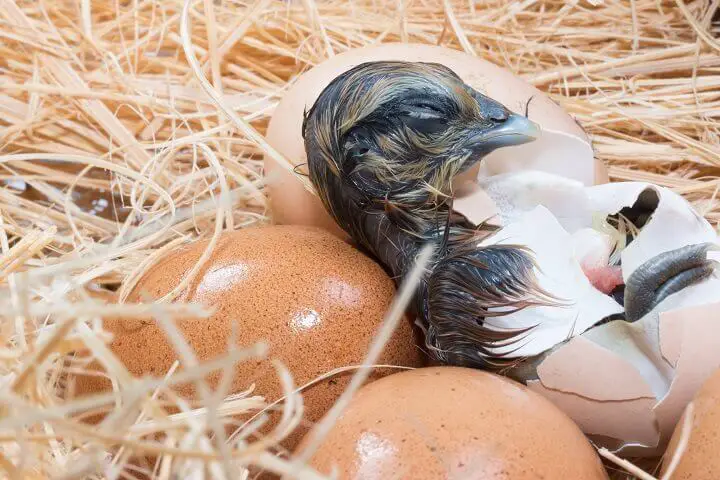
Hatching your own eggs can be quite rewarding since it allows you to witness the full life cycle of a chicken—from an eggshell to a fluffy little chick. Not only that, but hatching also gives you greater control over which breeds are added to your flock. You can purchase fertilized eggs from different sources and choose whichever breed best suits your needs and preferences.
Plus, when hatching at home, there are fewer chances of disease spreading among birds since they haven't been exposed to other flocks yet. Of course, hatching your own chickens allows for a more self-sufficient homestead as well.
How Many Chickens Should You Raise?
When it comes to deciding how many chickens to raise, where do you begin? How do you know when enough is enough? Here’s what you need to know about finding the right number of chickens for your homestead.
First, it’s important to consider your location. Rural areas and suburbs typically have looser regulations on how many chickens can be kept in one household than cities, so if you live in an urban area, check your local zoning laws before committing to any birds.
Also, be sure that whatever number of birds you decide on will fit comfortably in your coop or chicken run. Overcrowding can lead to health issues like parasites and poor air quality.
Before making a decision on how many chickens you should have, think about what needs they may fulfill in addition to providing fresh eggs. If you plan on using them for composting or fertilizing gardens and lawns, more birds will mean more manure which could come in handy for your garden projects.
If your main goal is to provide eggs for yourself or even sell them commercially, then fewer chickens might be a better option as they tend to lay fewer eggs as they age.
Research different breeds so that you understand different needs around housing size (i.e., small vs large) and egg production (i.e., high-laying vs low-laying).
Generally speaking, smaller breeds like Leghorns are great layers but require less space, while larger breeds like Orpingtons are great companion birds but need more room per bird due to their size.
Knowing what type of birds will work best with your space constraints can help narrow down your choice of breeds and ultimately determine how many birds is best for you given the space available.
Where Can You Buy Chicks?
Your first decision when it comes to buying chicks is whether you want to purchase them from a hatchery or a local farm store. Hatcheries are typically larger than farm stores and offer more variety of breeds and colors, so if you have your heart set on a specific type of bird, then this might be the way to go.
However, keep in mind that hatcheries usually order their chicks in batches of 25 or more at a time, so if you just need one or two birds, then purchasing from your local farm store may be the best option.
If you don’t have access to either a hatchery or local farm store, then shopping online for chicks might be your best bet. There are several websites that specialize in selling live chicks and hatching eggs. You can even find special breeders who specialize in rarer varieties like bantam chickens or silkie chickens. Just make sure to read all the reviews before committing—it pays off.
Related: How to Buy Your First Chickens
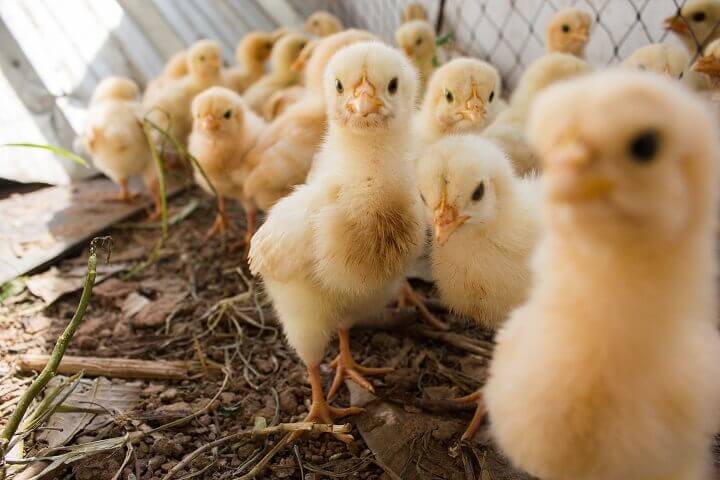
Tips for Buying Chicks, Pullets, or Chickens
Knowing what to look out for and what to expect when buying chickens will help ensure you get the perfect bird for your needs.
Selecting a Breed
The first step in buying the perfect chicken is selecting a breed that meets your needs. If you're looking for a pet, then consider breeds such as Silkies or Polish Chickens. If egg-laying is important, then consider breeds such as Australorps or Rhode Island Reds. And if you're looking for a meat bird, then consider Cornish Crosses.
Selecting Age & Size
Once you've selected a breed, it's time to decide on age and size. Baby chicks are cute and require very little space, but they require more work in terms of feeding and cleaning up after them until they get older and more independent.
Pullets are young hens that are ready to lay eggs soon but have not yet begun laying (usually between 4-6 months). Adult hens are already laying eggs but may be more expensive than pullets since they have already started producing eggs.
Examining the Birds
It's essential that you examine any birds you plan on purchasing before committing to buy them. Look at their feathers. Are they bright and shiny with no bald patches? Are their eyes clear? Is there any sign of discharge coming from their eyes or noses?
Also, check the underside of their wings. Make sure there is no redness indicating mites or lice infestation. Finally, look at their feet. Do they have all four toes with no signs of bumblefoot infection?
Tips for Hatching Your Own Chicks
Don't want to buy your own chicks, pullets (birds about to lay), or mature hens? If so, you have one other option: You can buy hatching eggs and hatch your own at home. Here are some tips on how to do it.
Start with Good Eggs
For starters, you’ll need to source good quality eggs. You can buy them online or from local hatcheries and feed stores. Avoid buying eggs from grocery stores as they have usually been refrigerated for so long that they are unsuitable for incubation. Even if that's not the case, most were laid by hens who were never with a rooster, and therefore, they are not fertilized.
Egg age should not exceed 10 days before setting them in an incubator.
Once your eggs have been chosen, mark them with something like a pencil or marker so that you know which way is up and which is down when placing them in the incubator tray. Also, if possible, look for eggs that are similar in size when choosing which ones to incubate; this will help ensure they all hatch at roughly the same time.
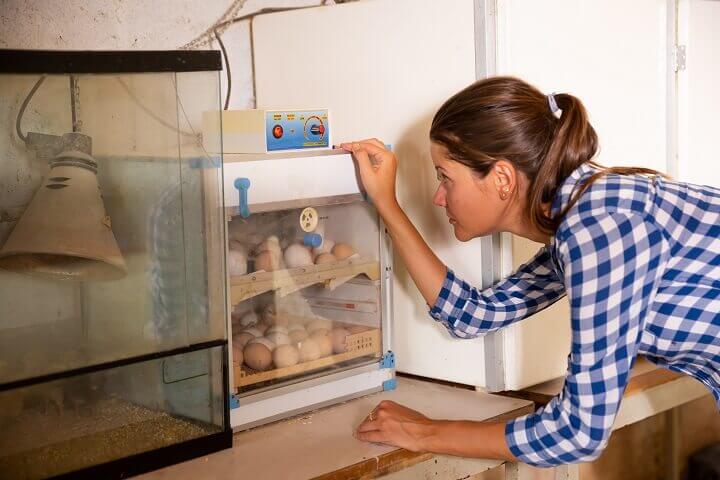
Choose an Incubator Wisely
Once you have your eggs, it’s time to select an incubator. There are several types of incubators available on the market, from basic models to advanced digital versions with temperature probes and features like automatic egg-turning mechanisms.
Ultimately, it depends on how much time you want to dedicate to checking on the progress of your hatchlings. If a hands-off approach is more your style, then opt for a digital version that will alert you when something needs attending to in the incubator itself.
Incubation Procedures
Before adding eggs to the incubator, make sure it’s set up properly and functioning correctly. Check that the temperature is between 99-101°F (37-38°C). Then add warm water to increase humidity in the incubator—this should be between 40-60%. Finally, carefully place your marked eggs into their individual compartments in the incubator tray.
This brings us to our next tip – temperature control. Keeping temperatures consistent throughout the entire process is essential if you want healthy chicks at the end of it all.
Digital thermometers are great tools because they allow you to monitor temperature fluctuations within a few degrees so any drastic changes can be addressed quickly and easily (ideally between 37°C-38°C). Humidity also plays an important role in creating optimal conditions for successful chick hatching, so keep an eye on that as well (ideally around 50%).
Wait Patiently
The next step is just waiting. Here’s where having patience pays off—it takes around 21 days from start to finish for a chick egg to hatch completely. During this time, check regularly but don't open the lid too often as this can reduce humidity levels inside of the incubator and affect hatching success rates.
What Breed of Chickens Should You Get?
Some people might think that all chickens are created equal, but that couldn’t be further from the truth. Different breeds of chickens lay different colors and sizes of eggs and have different personalities. Some are better suited for meat production, while others are better at laying eggs; some are good at both.
Let's take a look at some popular breeds and their characteristics.
The Rhode Island Red is one of the most popular breeds and is an excellent choice for backyard homesteaders. They lay large brown eggs almost every day and make great family pets. They're also great layers in cold weather and can tolerate confinement well.
Another breed to consider is the Orpington, which has a calm disposition and produces large brown eggs consistently throughout the year. It's also known for being quite hardy in colder climates.
For those looking for smaller birds that lay white or blue-green eggs, then consider Silkie Bantams or Araucanas—both are fun-sized birds with friendly personalities.
Of course, if you want a dual-purpose bird that can provide both meat and eggs year round, then consider Australorps or Plymouth Rocks—their large size makes them great producers of both kinds of protein.
And if you have more room on your homestead, then Barred Rocks or Jersey Giants may be what you're looking for—they grow larger than most other breeds so they produce more meat but still lay plenty of eggs too.
How to Set Up A Brooder
Here’s a guide for all chicken-raising hopefuls on how to set up a brooder.
Heat
Chicks can’t regulate their body temperature like adult chickens can, so your first priority when setting up the brooder is making sure they stay warm enough.
The ideal temperature is around 95 degrees Fahrenheit for the first week, then reducing by 5 degrees each week until they reach 70 degrees at 8 weeks old. You can adjust this using a heat lamp or heating pad – just make sure the temperatures are monitored often and adjusted accordingly.
Feeding
When it comes to food, chicks should have access to feed 24/7. Start with a starter feed that is specifically formulated for chicks, which is higher in protein than regular chicken feed. Once they reach about six weeks old, you can introduce them to other types of food including vegetables and fruit (no dairy.).
Bedding
The bedding material you choose will depend on your preferences and budget. Straw, wood shavings, and paper pellets are all popular choices. Just make sure it's dust-free and non-toxic (straw tends to be better in this regard). Change the bedding whenever needed so that it remains clean and dry.
Water
Chicks need constant access to clean water, otherwise they won't drink enough of it or may even die from dehydration. Use an automatic waterer or place shallow dishes filled with water instead. Just make sure whatever option you use keeps their water clean and free from dirt or debris.
Other Needs
Finally, make sure that your chicks have plenty of room to move around in their brooder box (at least 1 sq ft per chick).
Keep in mind that you can use just about any kind of structure you want for your brooder provided there is enough space. Many homesteaders save money by using things like old kiddie pools or Rubbermaid totes when they're first getting started.
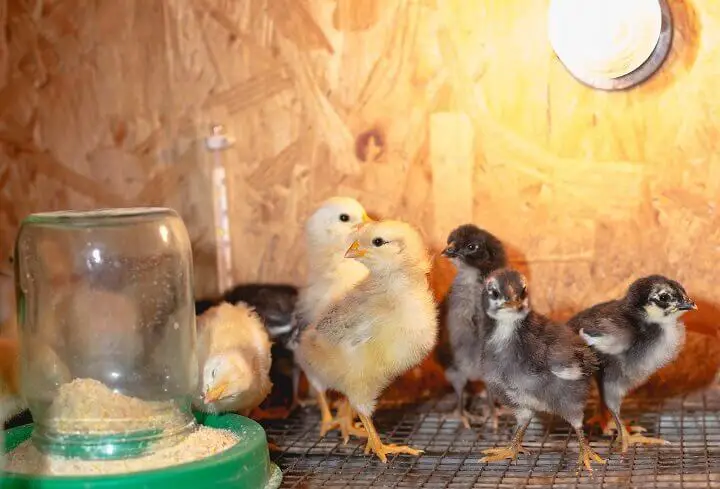
When to Transition Chickens to an Outdoor Setting
Most chickens can go outside when they are fully feathered and at least six weeks old. It’s important to make sure you have everything you need before allowing your chickens outside.
The most important thing you need is a safe enclosure for them; something that will protect them from predators like dogs and cats, as well as keep them away from any neighbors who may not appreciate having a few curious chickens in their backyard.
Make sure you also have plenty of food and water accessible so they don't get hungry or thirsty while they explore their new home.
When transitioning your chickens to an outdoor setting, start off slowly by introducing them gradually to their new environment.
Start off by taking them outside for short periods of time during the day and then work your way up to leaving them out overnight once they've gotten used to the outdoors. This will help ensure that they are comfortable in their new surroundings before being left alone entirely.
If possible, try to pick an area with lots of trees or shrubs for shade; this will help keep them cool in warmer months and provide shelter from rain or windy conditions in cooler months.
When you begin introducing your chickens to the coop, know that you may want to lock them inside for a couple of weeks before you allow them to free range. This will help them begin to recognize the coop as home so they will go in at night – where they will be protected from predators.
Designing Your Chicken Coop
Once you're ready to get your girls outside, here are some tips for designing their new home.
The Coop
Your coop should be strong yet breathable. Wood is often recommended for this reason. Depending on the size and number of birds you plan on housing, the coop should be at least 4 square feet per bird (or 8 cubic feet). It should have windows for ventilation and light, as well as a hinged door so that you can easily access the inside.
Bedding
Think of it like a bedroom for your chickens – they will need something soft and absorbent (like straw or wood shavings) to rest their little feet on. Make sure to change it out every few weeks or months depending on how many birds are housed in the coop. An easy way to do this is by using a deep litter system – adding new bedding atop existing bedding every few weeks until it's time for a full change out.
Nesting Boxes
Every good chicken coop needs nesting boxes where chickens can lay their eggs in peace.
Each box should measure 12x12x12 inches and should be lined with sawdust or straw for added comfort. You should also have one nesting box per four hens. If there aren’t enough boxes available, some hens may resort to laying their eggs elsewhere (like behind furniture or under shrubs).
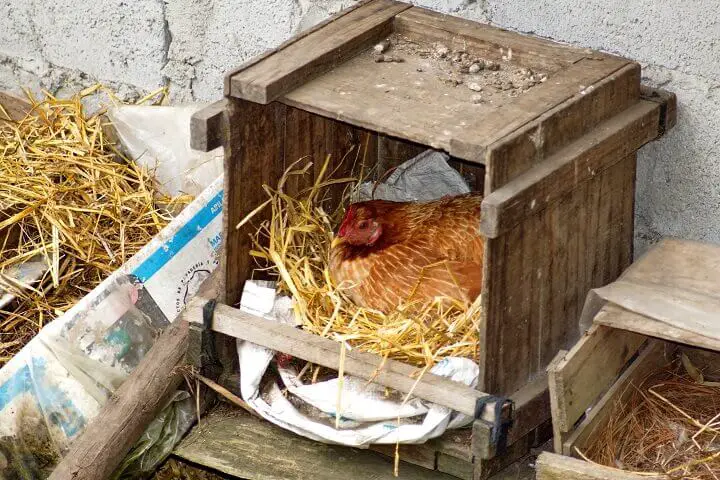
The Run
This is an outdoor area that provides ample space for chickens to run around and explore during the day when they’re not in their coop sleeping. The fencing can be made from plastic mesh wire or hardwood boards; just make sure whatever material you use is tall enough (at least 3ft) so that predators can’t get in and your chickens can't fly out.
Also, consider providing toys like swings or mirrors so that your chickens stay active and entertained while they’re outside playing in the run.
Other Accessories
To make sure your chicks are happy and healthy, it's important to provide them with items like roosting bars, feeders, waterers, dust baths, etc. Roosting bars give them somewhere comfortable and safe to sleep at night while feeders help keep food off the ground so it doesn't attract pests like mice or rats into your coop area.
Waterers are essential for keeping hydrated, especially during the hot weather months. Try investing in one with an automatic refill system so your chicks can always have access to clean water.
Dust baths help keep mites at bay, so make sure there's plenty of sand available for them too.
Alternatives to a Chicken Coop
If you don't have room for a traditional chicken coop but still want some feathered friends around, consider building something else instead — like a chicken tractor or mobile pen. These structures are much smaller than traditional coops but still offer protection from predators while allowing chickens more freedom range than just staying inside all day long.
Plus they're easier on the wallet too since most DIY plans only require basic materials like wood pallets and wire mesh panels.
Feeding and Watering Your Mature Chickens
Here are some more tips for caring for your older birds.
Feed
When it comes to feeding your mature chickens, it's important to provide them with a balanced diet full of proteins and healthy fats. A good rule of thumb is to give them a mix of grains, vegetables, fruits, bugs, and other treats.
Try providing them with greens like spinach or kale for snacks as well as cooked eggs for extra protein. It's also important to make sure that they have access to clean fresh water at all times.
What NOT to Feed to Chickens
There are certain foods that should never be fed to chickens such as raw potatoes or uncooked beans—these can be toxic for chickens if consumed in large quantities. Chocolate is another food item that should never be given to chickens as it can cause a range of digestive issues including colic, diarrhea, vomiting, and even death in extreme cases.
Finally, it's important not to overfeed your chicken as this can lead to obesity.
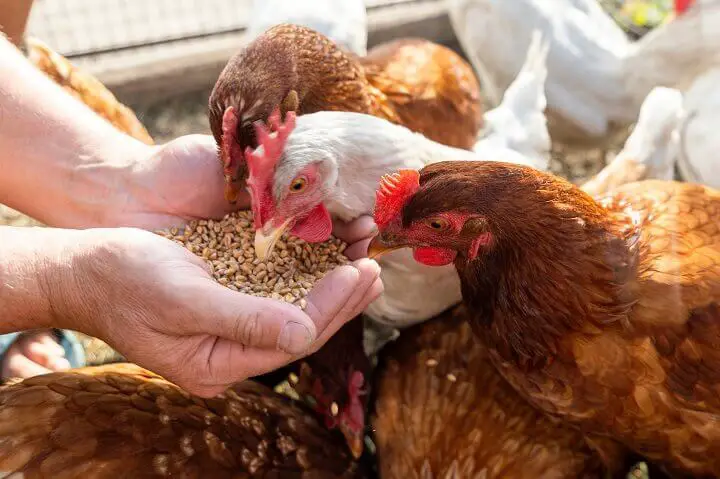
Water
It's essential for your chicken's health that they have access to clean water at all times. Make sure that their water bowl is regularly cleaned out so that bacteria doesn't proliferate.
Supplements
In addition to regular feedings, it's important that your chickens get the right supplements too. These include calcium supplements which help with bone development; Vitamin D3 which helps promote egg production; and probiotics which help maintain gut health and digestion. You can even give them medicinal herbs.
All these supplements are available from most pet stores or online retailers, so make sure you're getting the right ones for your flock. In most cases, you can also make your own – for example, chickens love crushed-up eggshells, which are an excellent source of calcium and don't cost anything to produce.
And do you need grit or chicken scratch? Maybe.
Grit is necessary for flocks who are not allowed to free range, but free-ranging birds can pick up the grit they need just from their daily pecking and scratching (it helps them digest their food). Chicken scratch, on the other hand, is mostly empty calories – it's really only necessary if your chickens are sick or injured.
Dealing With Common Chicken Health Concerns
If you’re a chicken owner, chances are you’ve encountered some health issues along the way. It can be difficult to identify what’s wrong with your chickens when they start showing signs of illness. Fortunately, there are some common chicken health concerns that can be easily identified and managed.
Mites and Lice
Mites and lice are small parasites that feed on your chickens’ blood, causing your chickens to become anemic, lose feathers, and potentially die if left untreated. The best way to deal with mites or lice is to inspect your birds regularly for signs of infestation, such as missing feathers or scabs on the skin.
If you spot any signs of mite or lice infestation, it’s important to take immediate action by treating the birds with a poultry dust bath. This will kill off any existing parasites while also preventing new ones from taking hold.
Be sure to wear protective clothing when dealing with mites or lice as they can spread quickly between chickens and humans.

Coccidiosis
Coccidiosis is an intestinal disease caused by a protozoan called coccidia which affects young chicks more than adult chickens. It causes diarrhea, weight loss, decreased appetite, dehydration, weakness and even death in extreme cases.
To prevent coccidiosis and other transmissible diseases (like Marek's disease) in chicks:
- Provide clean bedding material such as wood shavings or straw in the coop
- Change this material frequently so it stays dry
- Feed only high-quality starter feed
- Keep water clean
- Quarantine sick birds
- Practice good biosecurity measures
- Provide probiotics such as yogurt or raw eggs in their diet
- Ensure proper nutrition including plenty of fresh greens
- Vaccinate against coccidiosis if available in your area
- Dispose of manure properly
- Monitor for symptoms such as runny stools and take appropriate action if necessary.
Worms
Worms are another common chicken health concern that can cause ill thriftiness in chickens if left untreated for too long.
Common worms that infect chicken flocks include roundworms, gape worms (capillary worms), hairworms (capillaria worms), and caecal worms (nematodes).
To prevent worm infestations in your flock use worming products according to manufacturer instructions – typically twice per year – as well as regular deworming treatments every 6 months or so depending on climate conditions where you live.
Also, make sure that all new birds entering your flock have been tested for worms before allowing them into the coop.
How to Keep Predators Away From Your Chickens
Everyone knows that chickens are vulnerable to predators, but what exactly is out there that wants to take a bite out of your feathered friends? Here are some of the most common chicken predators – and tips on how to keep them away.
Recognize the Most Common Chicken Predators
Understanding what kinds of creatures might be after your flock is the first step to keeping them away.
If you live in an area with foxes or coyotes, they are definitely potential threats to your chickens. These predators typically hunt at night and can easily jump fences, so if you have free-ranging chickens, it is important to make sure they have a safe place to roost.
If your coop has a run, a sturdy fence will help keep these predators out. Additionally, motion-activated lights may scare away any would-be intruders.

Another common chicken predator is the raccoon or opossum. Raccoons love eggs and they can be quite adept at getting into coops so it’s best to make sure that your coop is as secure as possible with no openings large enough for them to enter through. A good rule of thumb is that if something smaller than a football can fit through it, then it should be closed off or covered up.
Keep in mind that raccoons are also very intelligent creatures, so if there's food in the vicinity they'll figure out how to get at it.
Cats and dogs may not seem like obvious predators of chickens, but they can still cause trouble for unsuspecting owners. If you do have any cats or dogs with access to the coop area, make sure they're up-to-date on all their vaccinations before allowing them near the birds – and keep a close eye on them to make sure they don't take a bite.
And don't forget about birds of prey. These can be tough predators to get rid of since there's no tall fence that will keep them out. You'll want to maintain a watchful eye on your flock and ensure that your birds aren't allowed out of the coop to free range when hawks or owls are amiss.
Use Visual Deterrents
Visual deterrents are anything that may scare off a predator, such as loud noises or bright lights. A good example of this is putting up a flag near your coop that flaps in the wind, making noise and catching an animal’s attention.
You can also try stringing up streamers around the perimeter of the coop or hanging CDs from strings on the fence to reflect light and make noise when the sun hits them.
Plant Herbs and Flowers
Certain herbs and flowers have strong smells that can repel animals like possums, raccoons, skunks, and even snakes. Some good plants for this purpose are chives, mint, lavender, rosemary, marigolds, and daffodils.
By planting these around your coop or in pots nearby, you can create an aroma that will make predators think twice before entering your chicken area.
Use Motion-Activated Sprinklers
Motion-activated sprinklers are great for deterring larger predators like coyotes or foxes who might be casing out your property looking for food sources. These usually come equipped with infrared sensors that detect movement and then spray out a short burst of water to startle any intruders away before they get too close.
Get a Guard Animal
If all else fails, you could always get a guard animal. Dogs (especially livestock guardian breeds) are great at protecting chickens from potential predators because they can sense when something isn’t quite right around them and alert their owners accordingly with barking or growling noises.
A donkey or llama is also another option, as these animals tend to be very territorial when it comes to protecting their home turf.
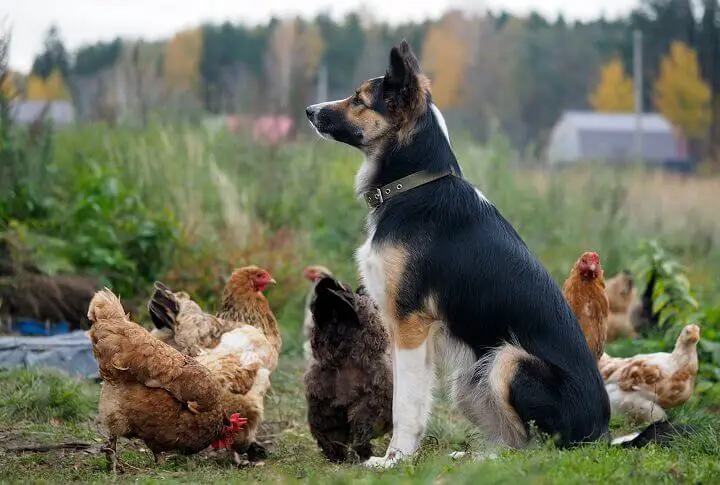
Final Thoughts
Raising chickens is a rewarding experience that offers many benefits—fresh eggs every morning, natural fertilizer for your garden, and even occasional entertainment thanks to their antics.
With proper preparation and care, you should be able to enjoy these benefits for years to come.
This guide covers all the basics of getting started with raising chickens; however, there are lots of other resources available if you want more information on specific topics such as breeds or egg production, many of which we linked to in this post.
So what are you waiting for? Get out there and start building your very own flock. Happy homesteading.
FAQ
Are chickens difficult to raise?
There is very little in terms of specialized knowledge required to start your own flock. Depending on your living circumstances, you'll simply need to acquire chickens and the feed they require.
Beyond that, it's all about providing a safe and comfortable place to live via shelter and bedding while ensuring they have enough room to take part in natural behaviors like dust bathing and scratching.
How many chickens should a homestead have?
A small homestead may not need more than three or four birds, while larger properties may accommodate up to twenty. Choosing the right breed will also influence egg production and size as well as flock dynamics.
How many chickens can you raise on 1 acre?
The amount of chickens you can raise on one acre depends on the type of chicken and how you are raising them. For example, if you are looking for egg-production and want to keep a flock of laying hens, you may be able to support up to 200 chickens in one acre.
However, if you want to raise broiler chickens with the intention of harvesting their meat, the number of birds you can house may be much lower due to the amount of space they require. Factors such as your climate will also have an impact on how many chickens your land can sustain.
What do homesteaders feed their chickens?
Chickens naturally forage for food and enjoy eating various plants, insects, and grubs. Homesteaders offer whole grains, either grown themselves or via commercial feed, such as corn, oats, barley, wheat, millet and rye. Here are some chicken foods you can produce yourself.
To add protein to the diet of their chickens, they throw mealworms, crickets and other live bugs into the chickens' habitat. To help with digestion, vegetable scraps from the kitchen are also regularly fed.
Like this post? Don't Forget to Pin It On Pinterest!
You May Also Like:









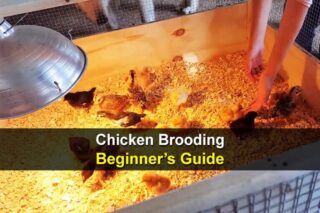


Many Cities, Towns and HOAs forbid livestock in including Chickens
You’re right. It’s important to check local ordinances before anyone builds that coop.
Raising chickens is EASY. Get them stilts.